BUS 5093 Marketing Management: Azul Airlines Product Choice Report
VerifiedAdded on 2022/01/24
|5
|1361
|321
Report
AI Summary
This report provides a detailed marketing analysis of Azul Airlines, a major Brazilian airline. The analysis covers the company's history, business model, target market, and brand image. It includes a SWOT analysis to evaluate Azul's strengths, weaknesses, opportunities, and threats. The report examines Azul's product choice, focusing on its expansion and customer-oriented culture. The analysis also considers the airline's financial performance, competitive landscape, and international operations. The report references various sources, including the Azul website, The New York Times, and Harvard Business Review, to support its findings. Overall, the report highlights Azul's growth and its strategies for maintaining a strong market position in the aviation industry. The report also discusses the impact of external factors, such as government involvement and global relationships, on the airline's operations and future development. The report concludes with a comprehensive overview of Azul's brand image and its efforts to improve business efficiency.
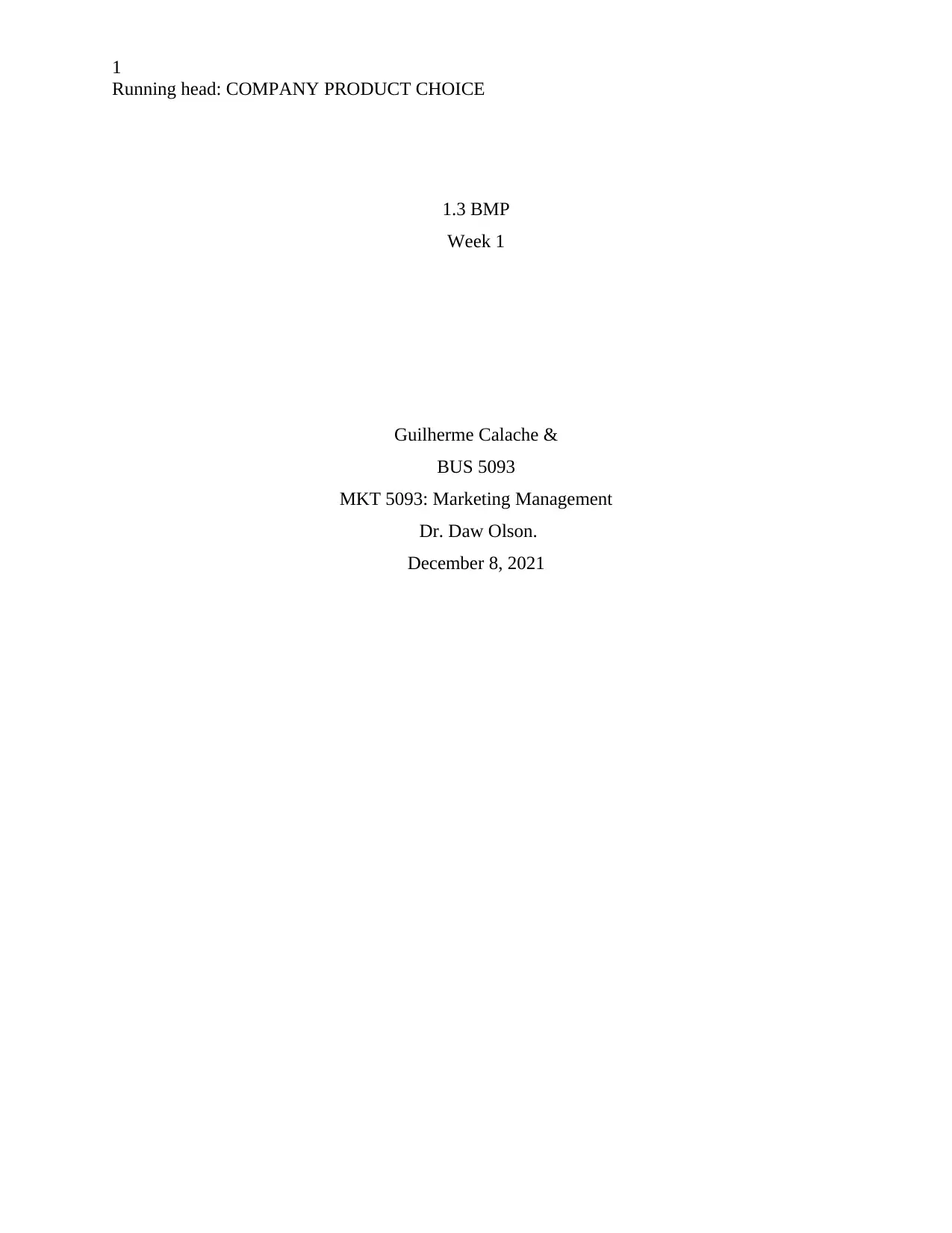
1
Running head: COMPANY PRODUCT CHOICE
1.3 BMP
Week 1
Guilherme Calache &
BUS 5093
MKT 5093: Marketing Management
Dr. Daw Olson.
December 8, 2021
Running head: COMPANY PRODUCT CHOICE
1.3 BMP
Week 1
Guilherme Calache &
BUS 5093
MKT 5093: Marketing Management
Dr. Daw Olson.
December 8, 2021
Paraphrase This Document
Need a fresh take? Get an instant paraphrase of this document with our AI Paraphraser
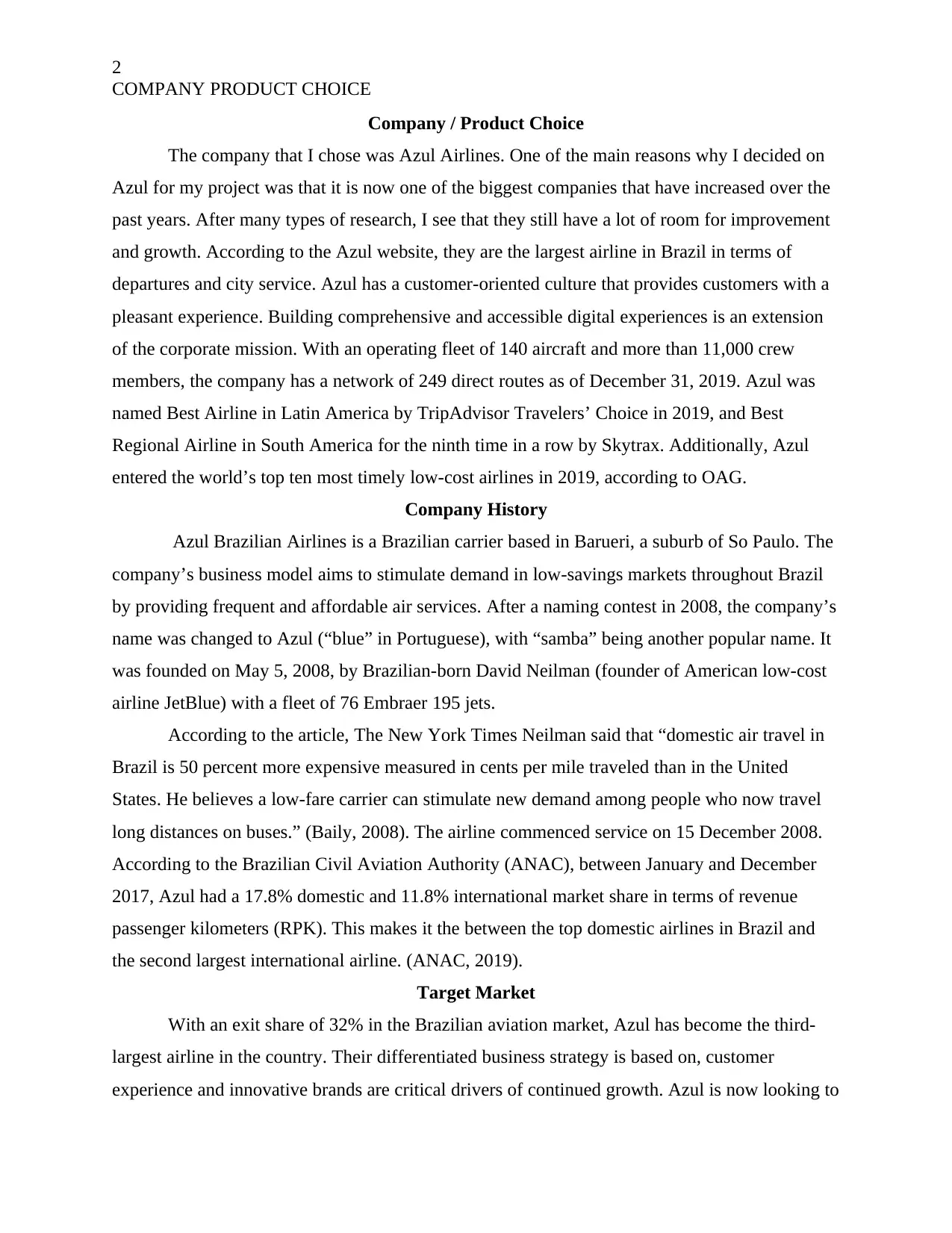
2
COMPANY PRODUCT CHOICE
Company / Product Choice
The company that I chose was Azul Airlines. One of the main reasons why I decided on
Azul for my project was that it is now one of the biggest companies that have increased over the
past years. After many types of research, I see that they still have a lot of room for improvement
and growth. According to the Azul website, they are the largest airline in Brazil in terms of
departures and city service. Azul has a customer-oriented culture that provides customers with a
pleasant experience. Building comprehensive and accessible digital experiences is an extension
of the corporate mission. With an operating fleet of 140 aircraft and more than 11,000 crew
members, the company has a network of 249 direct routes as of December 31, 2019. Azul was
named Best Airline in Latin America by TripAdvisor Travelers’ Choice in 2019, and Best
Regional Airline in South America for the ninth time in a row by Skytrax. Additionally, Azul
entered the world’s top ten most timely low-cost airlines in 2019, according to OAG.
Company History
Azul Brazilian Airlines is a Brazilian carrier based in Barueri, a suburb of So Paulo. The
company’s business model aims to stimulate demand in low-savings markets throughout Brazil
by providing frequent and affordable air services. After a naming contest in 2008, the company’s
name was changed to Azul (“blue” in Portuguese), with “samba” being another popular name. It
was founded on May 5, 2008, by Brazilian-born David Neilman (founder of American low-cost
airline JetBlue) with a fleet of 76 Embraer 195 jets.
According to the article, The New York Times Neilman said that “domestic air travel in
Brazil is 50 percent more expensive measured in cents per mile traveled than in the United
States. He believes a low-fare carrier can stimulate new demand among people who now travel
long distances on buses.” (Baily, 2008). The airline commenced service on 15 December 2008.
According to the Brazilian Civil Aviation Authority (ANAC), between January and December
2017, Azul had a 17.8% domestic and 11.8% international market share in terms of revenue
passenger kilometers (RPK). This makes it the between the top domestic airlines in Brazil and
the second largest international airline. (ANAC, 2019).
Target Market
With an exit share of 32% in the Brazilian aviation market, Azul has become the third-
largest airline in the country. Their differentiated business strategy is based on, customer
experience and innovative brands are critical drivers of continued growth. Azul is now looking to
COMPANY PRODUCT CHOICE
Company / Product Choice
The company that I chose was Azul Airlines. One of the main reasons why I decided on
Azul for my project was that it is now one of the biggest companies that have increased over the
past years. After many types of research, I see that they still have a lot of room for improvement
and growth. According to the Azul website, they are the largest airline in Brazil in terms of
departures and city service. Azul has a customer-oriented culture that provides customers with a
pleasant experience. Building comprehensive and accessible digital experiences is an extension
of the corporate mission. With an operating fleet of 140 aircraft and more than 11,000 crew
members, the company has a network of 249 direct routes as of December 31, 2019. Azul was
named Best Airline in Latin America by TripAdvisor Travelers’ Choice in 2019, and Best
Regional Airline in South America for the ninth time in a row by Skytrax. Additionally, Azul
entered the world’s top ten most timely low-cost airlines in 2019, according to OAG.
Company History
Azul Brazilian Airlines is a Brazilian carrier based in Barueri, a suburb of So Paulo. The
company’s business model aims to stimulate demand in low-savings markets throughout Brazil
by providing frequent and affordable air services. After a naming contest in 2008, the company’s
name was changed to Azul (“blue” in Portuguese), with “samba” being another popular name. It
was founded on May 5, 2008, by Brazilian-born David Neilman (founder of American low-cost
airline JetBlue) with a fleet of 76 Embraer 195 jets.
According to the article, The New York Times Neilman said that “domestic air travel in
Brazil is 50 percent more expensive measured in cents per mile traveled than in the United
States. He believes a low-fare carrier can stimulate new demand among people who now travel
long distances on buses.” (Baily, 2008). The airline commenced service on 15 December 2008.
According to the Brazilian Civil Aviation Authority (ANAC), between January and December
2017, Azul had a 17.8% domestic and 11.8% international market share in terms of revenue
passenger kilometers (RPK). This makes it the between the top domestic airlines in Brazil and
the second largest international airline. (ANAC, 2019).
Target Market
With an exit share of 32% in the Brazilian aviation market, Azul has become the third-
largest airline in the country. Their differentiated business strategy is based on, customer
experience and innovative brands are critical drivers of continued growth. Azul is now looking to
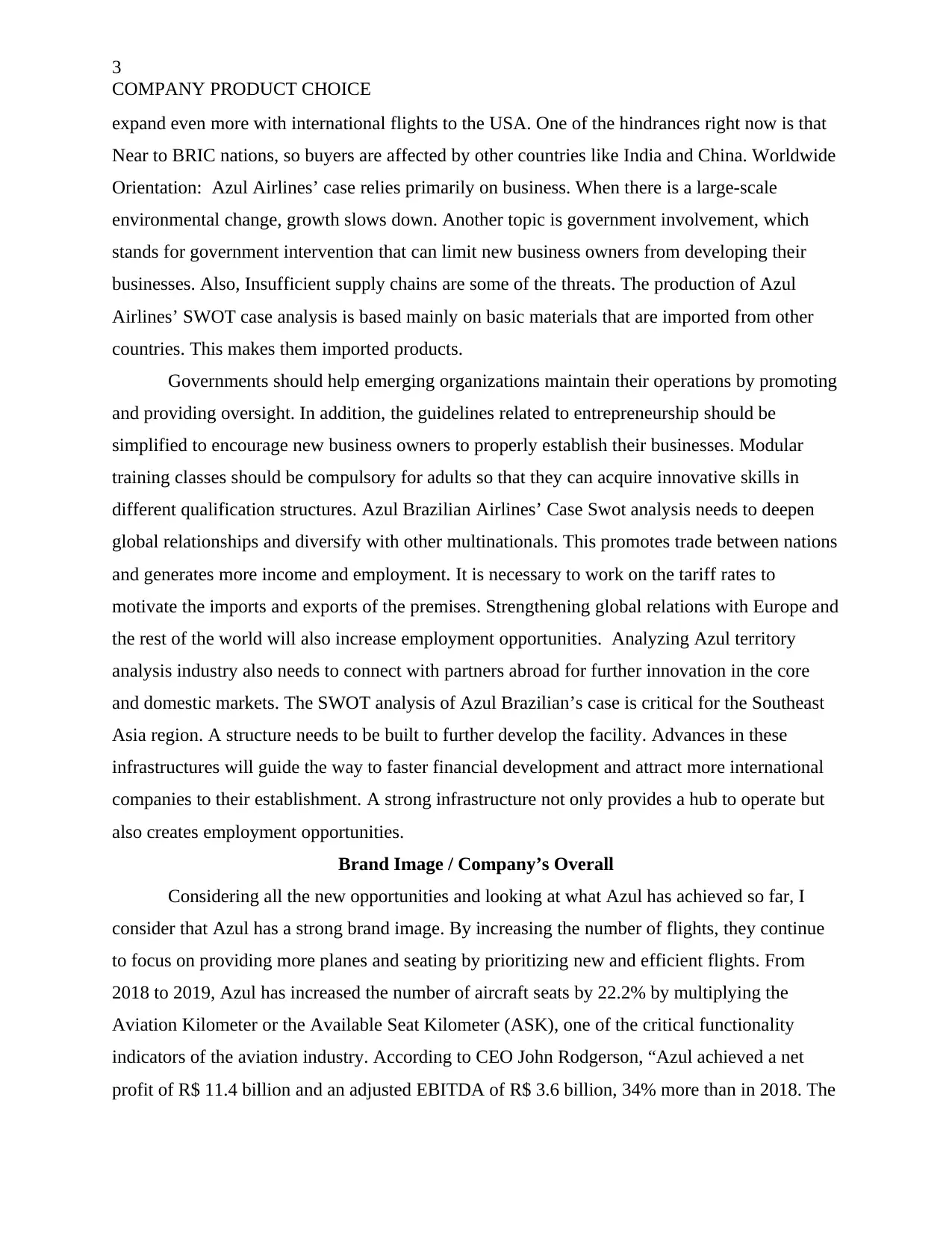
3
COMPANY PRODUCT CHOICE
expand even more with international flights to the USA. One of the hindrances right now is that
Near to BRIC nations, so buyers are affected by other countries like India and China. Worldwide
Orientation: Azul Airlines’ case relies primarily on business. When there is a large-scale
environmental change, growth slows down. Another topic is government involvement, which
stands for government intervention that can limit new business owners from developing their
businesses. Also, Insufficient supply chains are some of the threats. The production of Azul
Airlines’ SWOT case analysis is based mainly on basic materials that are imported from other
countries. This makes them imported products.
Governments should help emerging organizations maintain their operations by promoting
and providing oversight. In addition, the guidelines related to entrepreneurship should be
simplified to encourage new business owners to properly establish their businesses. Modular
training classes should be compulsory for adults so that they can acquire innovative skills in
different qualification structures. Azul Brazilian Airlines’ Case Swot analysis needs to deepen
global relationships and diversify with other multinationals. This promotes trade between nations
and generates more income and employment. It is necessary to work on the tariff rates to
motivate the imports and exports of the premises. Strengthening global relations with Europe and
the rest of the world will also increase employment opportunities. Analyzing Azul territory
analysis industry also needs to connect with partners abroad for further innovation in the core
and domestic markets. The SWOT analysis of Azul Brazilian’s case is critical for the Southeast
Asia region. A structure needs to be built to further develop the facility. Advances in these
infrastructures will guide the way to faster financial development and attract more international
companies to their establishment. A strong infrastructure not only provides a hub to operate but
also creates employment opportunities.
Brand Image / Company’s Overall
Considering all the new opportunities and looking at what Azul has achieved so far, I
consider that Azul has a strong brand image. By increasing the number of flights, they continue
to focus on providing more planes and seating by prioritizing new and efficient flights. From
2018 to 2019, Azul has increased the number of aircraft seats by 22.2% by multiplying the
Aviation Kilometer or the Available Seat Kilometer (ASK), one of the critical functionality
indicators of the aviation industry. According to CEO John Rodgerson, “Azul achieved a net
profit of R$ 11.4 billion and an adjusted EBITDA of R$ 3.6 billion, 34% more than in 2018. The
COMPANY PRODUCT CHOICE
expand even more with international flights to the USA. One of the hindrances right now is that
Near to BRIC nations, so buyers are affected by other countries like India and China. Worldwide
Orientation: Azul Airlines’ case relies primarily on business. When there is a large-scale
environmental change, growth slows down. Another topic is government involvement, which
stands for government intervention that can limit new business owners from developing their
businesses. Also, Insufficient supply chains are some of the threats. The production of Azul
Airlines’ SWOT case analysis is based mainly on basic materials that are imported from other
countries. This makes them imported products.
Governments should help emerging organizations maintain their operations by promoting
and providing oversight. In addition, the guidelines related to entrepreneurship should be
simplified to encourage new business owners to properly establish their businesses. Modular
training classes should be compulsory for adults so that they can acquire innovative skills in
different qualification structures. Azul Brazilian Airlines’ Case Swot analysis needs to deepen
global relationships and diversify with other multinationals. This promotes trade between nations
and generates more income and employment. It is necessary to work on the tariff rates to
motivate the imports and exports of the premises. Strengthening global relations with Europe and
the rest of the world will also increase employment opportunities. Analyzing Azul territory
analysis industry also needs to connect with partners abroad for further innovation in the core
and domestic markets. The SWOT analysis of Azul Brazilian’s case is critical for the Southeast
Asia region. A structure needs to be built to further develop the facility. Advances in these
infrastructures will guide the way to faster financial development and attract more international
companies to their establishment. A strong infrastructure not only provides a hub to operate but
also creates employment opportunities.
Brand Image / Company’s Overall
Considering all the new opportunities and looking at what Azul has achieved so far, I
consider that Azul has a strong brand image. By increasing the number of flights, they continue
to focus on providing more planes and seating by prioritizing new and efficient flights. From
2018 to 2019, Azul has increased the number of aircraft seats by 22.2% by multiplying the
Aviation Kilometer or the Available Seat Kilometer (ASK), one of the critical functionality
indicators of the aviation industry. According to CEO John Rodgerson, “Azul achieved a net
profit of R$ 11.4 billion and an adjusted EBITDA of R$ 3.6 billion, 34% more than in 2018. The
⊘ This is a preview!⊘
Do you want full access?
Subscribe today to unlock all pages.

Trusted by 1+ million students worldwide
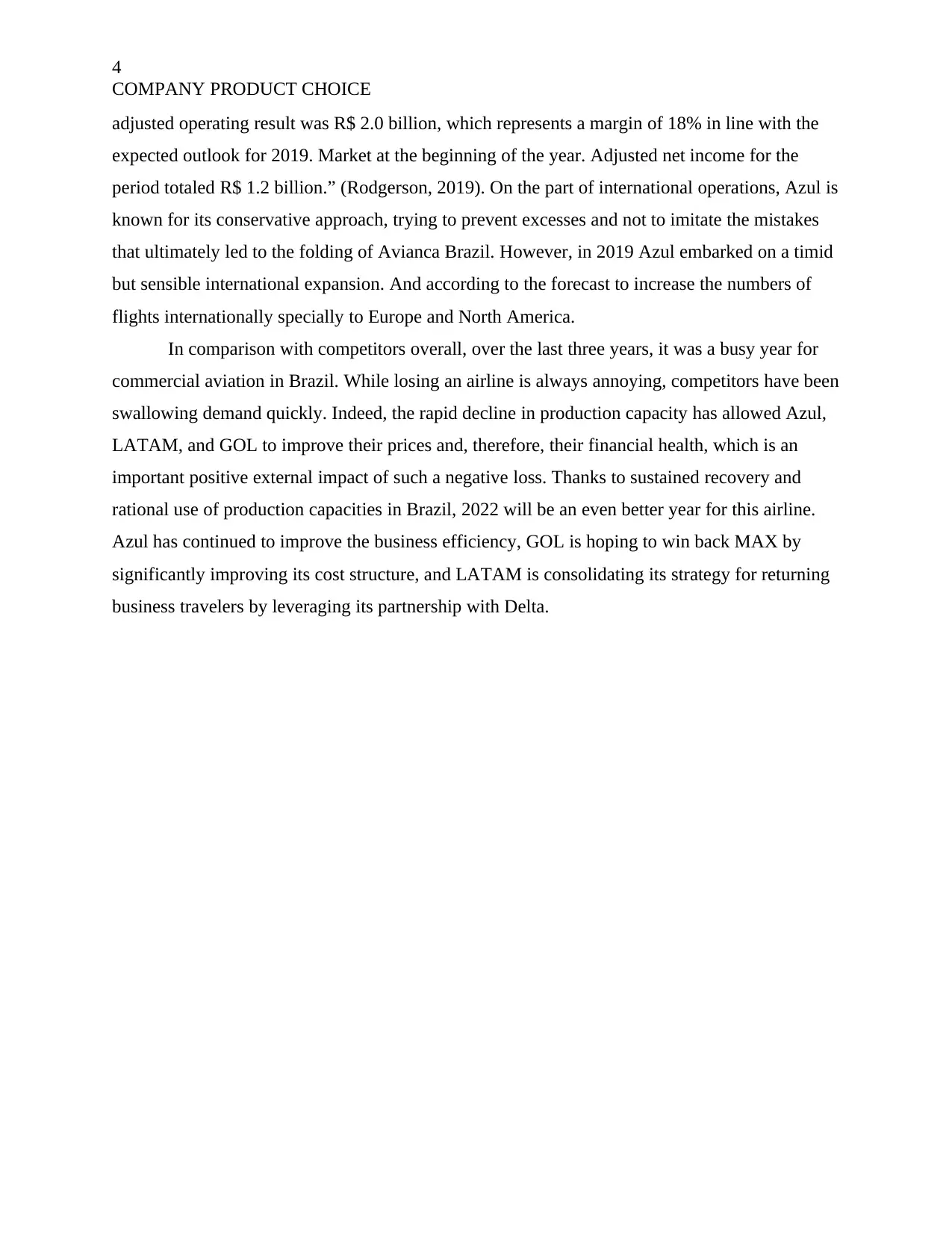
4
COMPANY PRODUCT CHOICE
adjusted operating result was R$ 2.0 billion, which represents a margin of 18% in line with the
expected outlook for 2019. Market at the beginning of the year. Adjusted net income for the
period totaled R$ 1.2 billion.” (Rodgerson, 2019). On the part of international operations, Azul is
known for its conservative approach, trying to prevent excesses and not to imitate the mistakes
that ultimately led to the folding of Avianca Brazil. However, in 2019 Azul embarked on a timid
but sensible international expansion. And according to the forecast to increase the numbers of
flights internationally specially to Europe and North America.
In comparison with competitors overall, over the last three years, it was a busy year for
commercial aviation in Brazil. While losing an airline is always annoying, competitors have been
swallowing demand quickly. Indeed, the rapid decline in production capacity has allowed Azul,
LATAM, and GOL to improve their prices and, therefore, their financial health, which is an
important positive external impact of such a negative loss. Thanks to sustained recovery and
rational use of production capacities in Brazil, 2022 will be an even better year for this airline.
Azul has continued to improve the business efficiency, GOL is hoping to win back MAX by
significantly improving its cost structure, and LATAM is consolidating its strategy for returning
business travelers by leveraging its partnership with Delta.
COMPANY PRODUCT CHOICE
adjusted operating result was R$ 2.0 billion, which represents a margin of 18% in line with the
expected outlook for 2019. Market at the beginning of the year. Adjusted net income for the
period totaled R$ 1.2 billion.” (Rodgerson, 2019). On the part of international operations, Azul is
known for its conservative approach, trying to prevent excesses and not to imitate the mistakes
that ultimately led to the folding of Avianca Brazil. However, in 2019 Azul embarked on a timid
but sensible international expansion. And according to the forecast to increase the numbers of
flights internationally specially to Europe and North America.
In comparison with competitors overall, over the last three years, it was a busy year for
commercial aviation in Brazil. While losing an airline is always annoying, competitors have been
swallowing demand quickly. Indeed, the rapid decline in production capacity has allowed Azul,
LATAM, and GOL to improve their prices and, therefore, their financial health, which is an
important positive external impact of such a negative loss. Thanks to sustained recovery and
rational use of production capacities in Brazil, 2022 will be an even better year for this airline.
Azul has continued to improve the business efficiency, GOL is hoping to win back MAX by
significantly improving its cost structure, and LATAM is consolidating its strategy for returning
business travelers by leveraging its partnership with Delta.
Paraphrase This Document
Need a fresh take? Get an instant paraphrase of this document with our AI Paraphraser
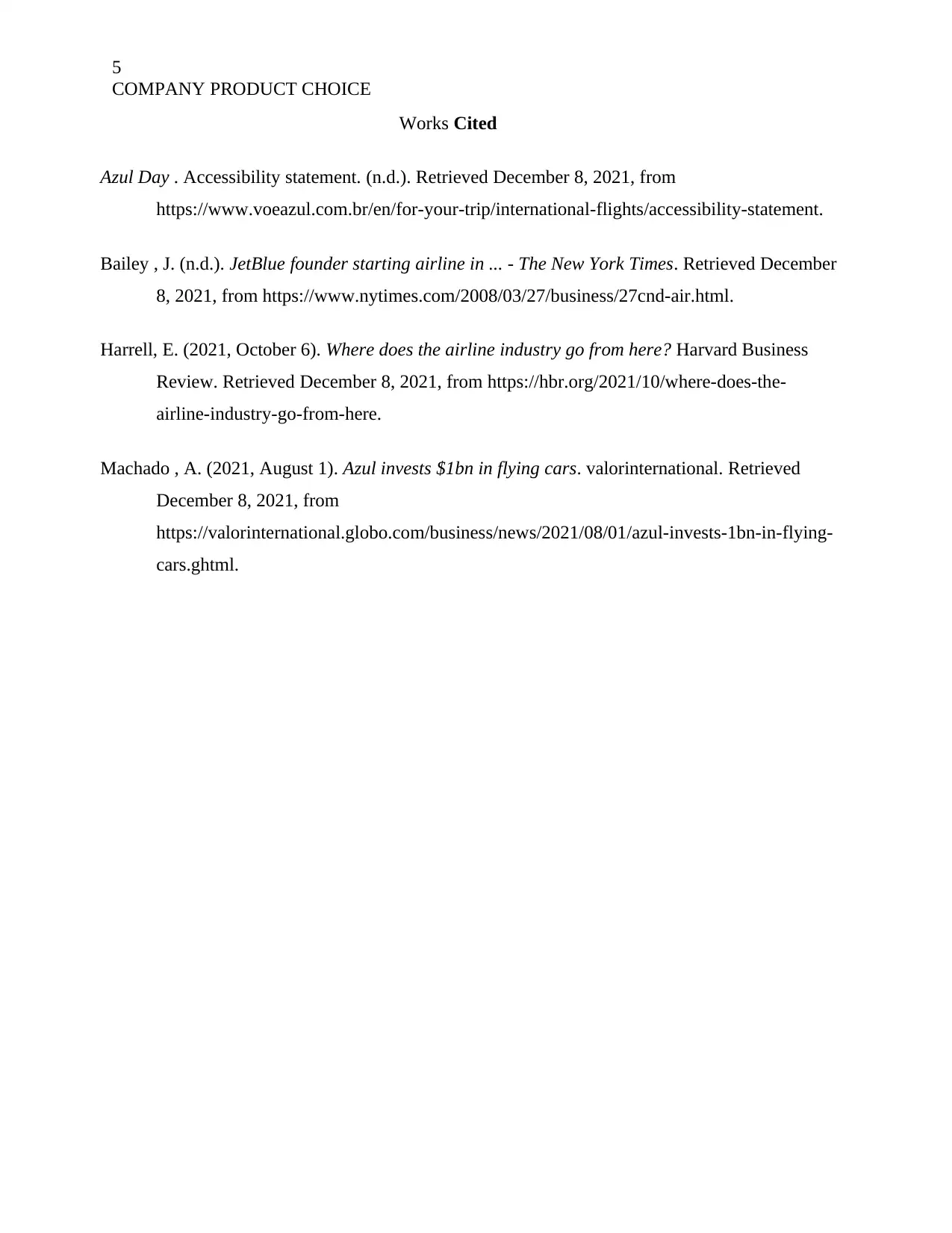
5
COMPANY PRODUCT CHOICE
Works Cited
Azul Day . Accessibility statement. (n.d.). Retrieved December 8, 2021, from
https://www.voeazul.com.br/en/for-your-trip/international-flights/accessibility-statement.
Bailey , J. (n.d.). JetBlue founder starting airline in ... - The New York Times. Retrieved December
8, 2021, from https://www.nytimes.com/2008/03/27/business/27cnd-air.html.
Harrell, E. (2021, October 6). Where does the airline industry go from here? Harvard Business
Review. Retrieved December 8, 2021, from https://hbr.org/2021/10/where-does-the-
airline-industry-go-from-here.
Machado , A. (2021, August 1). Azul invests $1bn in flying cars. valorinternational. Retrieved
December 8, 2021, from
https://valorinternational.globo.com/business/news/2021/08/01/azul-invests-1bn-in-flying-
cars.ghtml.
COMPANY PRODUCT CHOICE
Works Cited
Azul Day . Accessibility statement. (n.d.). Retrieved December 8, 2021, from
https://www.voeazul.com.br/en/for-your-trip/international-flights/accessibility-statement.
Bailey , J. (n.d.). JetBlue founder starting airline in ... - The New York Times. Retrieved December
8, 2021, from https://www.nytimes.com/2008/03/27/business/27cnd-air.html.
Harrell, E. (2021, October 6). Where does the airline industry go from here? Harvard Business
Review. Retrieved December 8, 2021, from https://hbr.org/2021/10/where-does-the-
airline-industry-go-from-here.
Machado , A. (2021, August 1). Azul invests $1bn in flying cars. valorinternational. Retrieved
December 8, 2021, from
https://valorinternational.globo.com/business/news/2021/08/01/azul-invests-1bn-in-flying-
cars.ghtml.
1 out of 5
Related Documents
Your All-in-One AI-Powered Toolkit for Academic Success.
+13062052269
info@desklib.com
Available 24*7 on WhatsApp / Email
![[object Object]](/_next/static/media/star-bottom.7253800d.svg)
Unlock your academic potential
Copyright © 2020–2025 A2Z Services. All Rights Reserved. Developed and managed by ZUCOL.





